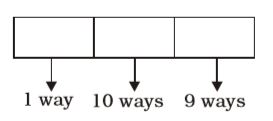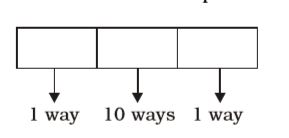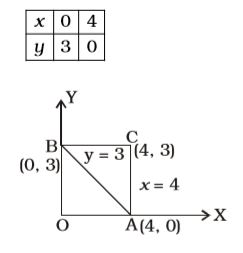Algebra
- The total number of integers between 200 and 400, each of which either begins with 3 or ends with 3 or both, is
-
View Hint View Answer Discuss in Forum
When 3 lies at hundreds place

∴ Total integers = 10 × 9 = 90
When 3 lies at units place
Total integers = 10
When 3 lies at unit’s and hundred’s place
Total integers = 10
∴ Total integers = 90 + 10 +10 = 110Correct Option: C
When 3 lies at hundreds place

∴ Total integers = 10 × 9 = 90
When 3 lies at units place
Total integers = 10
When 3 lies at unit’s and hundred’s place
Total integers = 10
∴ Total integers = 90 + 10 +10 = 110
- The area (in square units) of the triangle formed by the graphs of the equations x = 4, y = 3 and 3x + 4y = 12 ; is
-
View Hint View Answer Discuss in Forum
On putting x = 0 in the equation 3x + 4y = 12,
4y = 12, ⇒ y = 3
Again on putting y = 0,
3x = 12 ⇒ x = 4
∴ Area of ∆ABC = 1 × AC × BC = 1 × 3 × 4 = 6 sq. units 2 2 Correct Option: C
On putting x = 0 in the equation 3x + 4y = 12,
4y = 12, ⇒ y = 3
Again on putting y = 0,
3x = 12 ⇒ x = 4
∴ Area of ∆ABC = 1 × AC × BC = 1 × 3 × 4 = 6 sq. units 2 2
- If 2x + y = 6 and x = 2 are two linear equations, then graph of two equations meet at a point :
-
View Hint View Answer Discuss in Forum
Putting x = 2 in the equation
2x + y = 6,
2 × 2 + y = 6
⇒ y = 6 – 4 = 2
∴ Required point = (2, 2)Correct Option: C
Putting x = 2 in the equation
2x + y = 6,
2 × 2 + y = 6
⇒ y = 6 – 4 = 2
∴ Required point = (2, 2)
- If x + y = 1 + xy, then x3 + y3 – x3y3 is equal to :
-
View Hint View Answer Discuss in Forum
x + y = 1 + xy (given)
∴ x3 + y3 - x3.y3 = (x + y)3 – 3xy (x + y) – x3y3
x3 + y3 - x3.y3 = (1 + xy)3 – 3xy (1 + xy) – x3y3
x3 + y3 - x3.y3 = 1 + x3y3 + 3xy + 3x2y2 - 3xy - 3x2y2 - x3y3 = 1Correct Option: B
x + y = 1 + xy (given)
∴ x3 + y3 - x3.y3 = (x + y)3 – 3xy (x + y) – x3y3
x3 + y3 - x3.y3 = (1 + xy)3 – 3xy (1 + xy) – x3y3
x3 + y3 - x3.y3 = 1 + x3y3 + 3xy + 3x2y2 - 3xy - 3x2y2 - x3y3 = 1
-
If x + 5 + 1 = 6, then the value of (x + 1)3 + 1 is x + 1 (x + 1)3
-
View Hint View Answer Discuss in Forum
x + 5 + 1 = 6 x + 1 ⇒ (x + 1) + 1 = 6 – 4 = 2 (x + 1)
On cubing both sides,
⇒ (x + 1)3 + 1 + 3 × 2 = 8 (x + 1)3 ⇒ (x + 1)3 + 1 = 8 – 6 = 2 (x + 1)3 Correct Option: A
x + 5 + 1 = 6 x + 1 ⇒ (x + 1) + 1 = 6 – 4 = 2 (x + 1)
On cubing both sides,
⇒ (x + 1)3 + 1 + 3 × 2 = 8 (x + 1)3 ⇒ (x + 1)3 + 1 = 8 – 6 = 2 (x + 1)3

